Analysis of HRM Functions and Strategies at Greggs: A Detailed Report
VerifiedAdded on 2020/10/22
|16
|4752
|53
Report
AI Summary
This report provides a comprehensive analysis of Human Resource Management (HRM) practices within Greggs, a leading UK bakery chain. Task 1 introduces the role of HRM in achieving organizational goals, focusing on recruitment and selection approaches, including internal and external methods. It evaluates the strengths and weaknesses of each approach. Task 2 assesses the benefits and effectiveness of HRM practices such as workforce planning, recruitment and selection, training and development, and performance management, highlighting their impact on employee relations and engagement. It also evaluates key areas of employment legislation relevant to Greggs. Task 3 delves into the application of HRM practices within the organization. The report covers various aspects of HRM, aiming to provide insights into how Greggs manages its workforce to achieve its objectives, retain employees and maintain a competitive edge in the market. The report is a valuable resource for understanding HRM in a real-world business context.
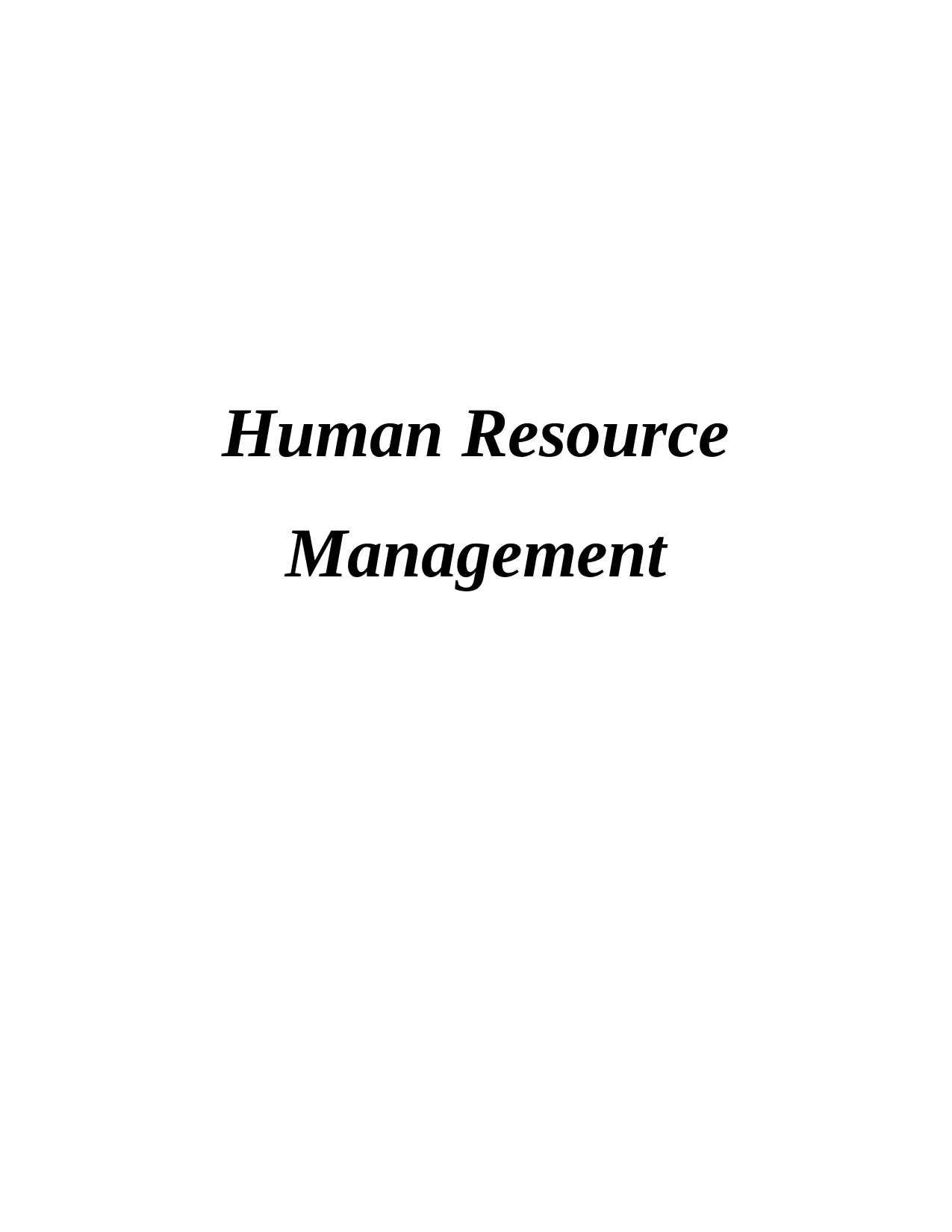
Human Resource
Management
Management
Paraphrase This Document
Need a fresh take? Get an instant paraphrase of this document with our AI Paraphraser
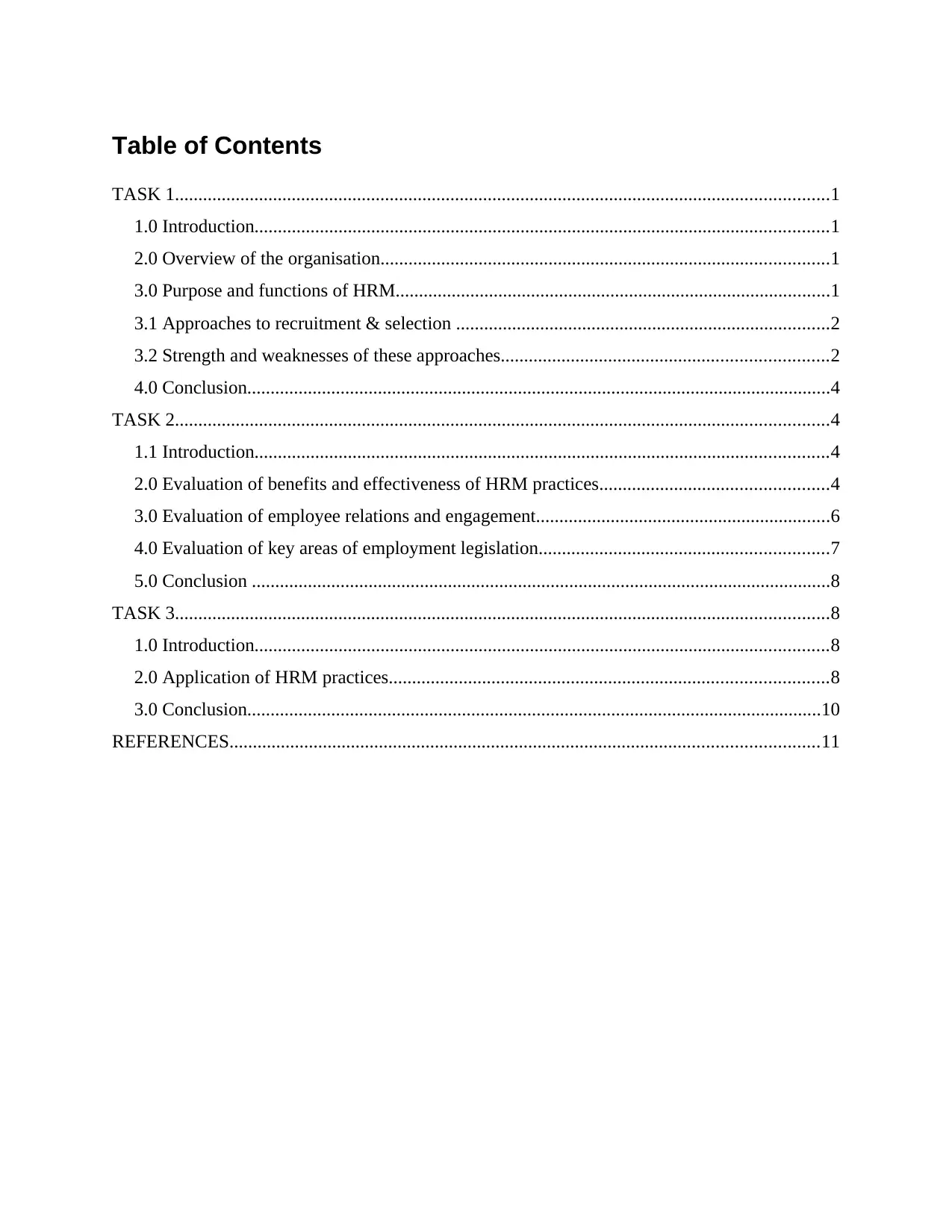
Table of Contents
TASK 1............................................................................................................................................1
1.0 Introduction...........................................................................................................................1
2.0 Overview of the organisation................................................................................................1
3.0 Purpose and functions of HRM.............................................................................................1
3.1 Approaches to recruitment & selection ................................................................................2
3.2 Strength and weaknesses of these approaches......................................................................2
4.0 Conclusion.............................................................................................................................4
TASK 2............................................................................................................................................4
1.1 Introduction...........................................................................................................................4
2.0 Evaluation of benefits and effectiveness of HRM practices.................................................4
3.0 Evaluation of employee relations and engagement...............................................................6
4.0 Evaluation of key areas of employment legislation..............................................................7
5.0 Conclusion ............................................................................................................................8
TASK 3............................................................................................................................................8
1.0 Introduction...........................................................................................................................8
2.0 Application of HRM practices..............................................................................................8
3.0 Conclusion...........................................................................................................................10
REFERENCES..............................................................................................................................11
TASK 1............................................................................................................................................1
1.0 Introduction...........................................................................................................................1
2.0 Overview of the organisation................................................................................................1
3.0 Purpose and functions of HRM.............................................................................................1
3.1 Approaches to recruitment & selection ................................................................................2
3.2 Strength and weaknesses of these approaches......................................................................2
4.0 Conclusion.............................................................................................................................4
TASK 2............................................................................................................................................4
1.1 Introduction...........................................................................................................................4
2.0 Evaluation of benefits and effectiveness of HRM practices.................................................4
3.0 Evaluation of employee relations and engagement...............................................................6
4.0 Evaluation of key areas of employment legislation..............................................................7
5.0 Conclusion ............................................................................................................................8
TASK 3............................................................................................................................................8
1.0 Introduction...........................................................................................................................8
2.0 Application of HRM practices..............................................................................................8
3.0 Conclusion...........................................................................................................................10
REFERENCES..............................................................................................................................11
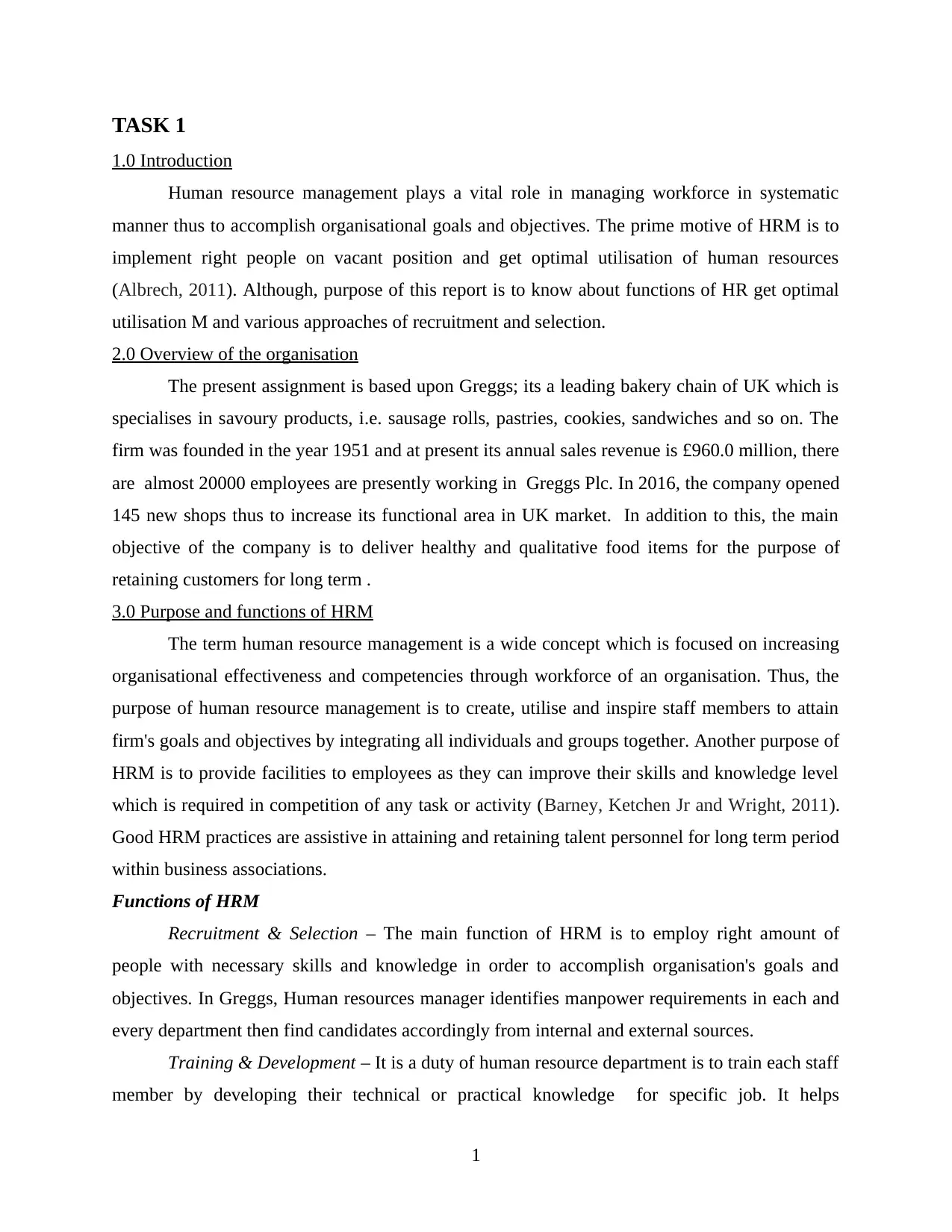
TASK 1
1.0 Introduction
Human resource management plays a vital role in managing workforce in systematic
manner thus to accomplish organisational goals and objectives. The prime motive of HRM is to
implement right people on vacant position and get optimal utilisation of human resources
(Albrech, 2011). Although, purpose of this report is to know about functions of HR get optimal
utilisation M and various approaches of recruitment and selection.
2.0 Overview of the organisation
The present assignment is based upon Greggs; its a leading bakery chain of UK which is
specialises in savoury products, i.e. sausage rolls, pastries, cookies, sandwiches and so on. The
firm was founded in the year 1951 and at present its annual sales revenue is £960.0 million, there
are almost 20000 employees are presently working in Greggs Plc. In 2016, the company opened
145 new shops thus to increase its functional area in UK market. In addition to this, the main
objective of the company is to deliver healthy and qualitative food items for the purpose of
retaining customers for long term .
3.0 Purpose and functions of HRM
The term human resource management is a wide concept which is focused on increasing
organisational effectiveness and competencies through workforce of an organisation. Thus, the
purpose of human resource management is to create, utilise and inspire staff members to attain
firm's goals and objectives by integrating all individuals and groups together. Another purpose of
HRM is to provide facilities to employees as they can improve their skills and knowledge level
which is required in competition of any task or activity (Barney, Ketchen Jr and Wright, 2011).
Good HRM practices are assistive in attaining and retaining talent personnel for long term period
within business associations.
Functions of HRM
Recruitment & Selection – The main function of HRM is to employ right amount of
people with necessary skills and knowledge in order to accomplish organisation's goals and
objectives. In Greggs, Human resources manager identifies manpower requirements in each and
every department then find candidates accordingly from internal and external sources.
Training & Development – It is a duty of human resource department is to train each staff
member by developing their technical or practical knowledge for specific job. It helps
1
1.0 Introduction
Human resource management plays a vital role in managing workforce in systematic
manner thus to accomplish organisational goals and objectives. The prime motive of HRM is to
implement right people on vacant position and get optimal utilisation of human resources
(Albrech, 2011). Although, purpose of this report is to know about functions of HR get optimal
utilisation M and various approaches of recruitment and selection.
2.0 Overview of the organisation
The present assignment is based upon Greggs; its a leading bakery chain of UK which is
specialises in savoury products, i.e. sausage rolls, pastries, cookies, sandwiches and so on. The
firm was founded in the year 1951 and at present its annual sales revenue is £960.0 million, there
are almost 20000 employees are presently working in Greggs Plc. In 2016, the company opened
145 new shops thus to increase its functional area in UK market. In addition to this, the main
objective of the company is to deliver healthy and qualitative food items for the purpose of
retaining customers for long term .
3.0 Purpose and functions of HRM
The term human resource management is a wide concept which is focused on increasing
organisational effectiveness and competencies through workforce of an organisation. Thus, the
purpose of human resource management is to create, utilise and inspire staff members to attain
firm's goals and objectives by integrating all individuals and groups together. Another purpose of
HRM is to provide facilities to employees as they can improve their skills and knowledge level
which is required in competition of any task or activity (Barney, Ketchen Jr and Wright, 2011).
Good HRM practices are assistive in attaining and retaining talent personnel for long term period
within business associations.
Functions of HRM
Recruitment & Selection – The main function of HRM is to employ right amount of
people with necessary skills and knowledge in order to accomplish organisation's goals and
objectives. In Greggs, Human resources manager identifies manpower requirements in each and
every department then find candidates accordingly from internal and external sources.
Training & Development – It is a duty of human resource department is to train each staff
member by developing their technical or practical knowledge for specific job. It helps
1
⊘ This is a preview!⊘
Do you want full access?
Subscribe today to unlock all pages.

Trusted by 1+ million students worldwide
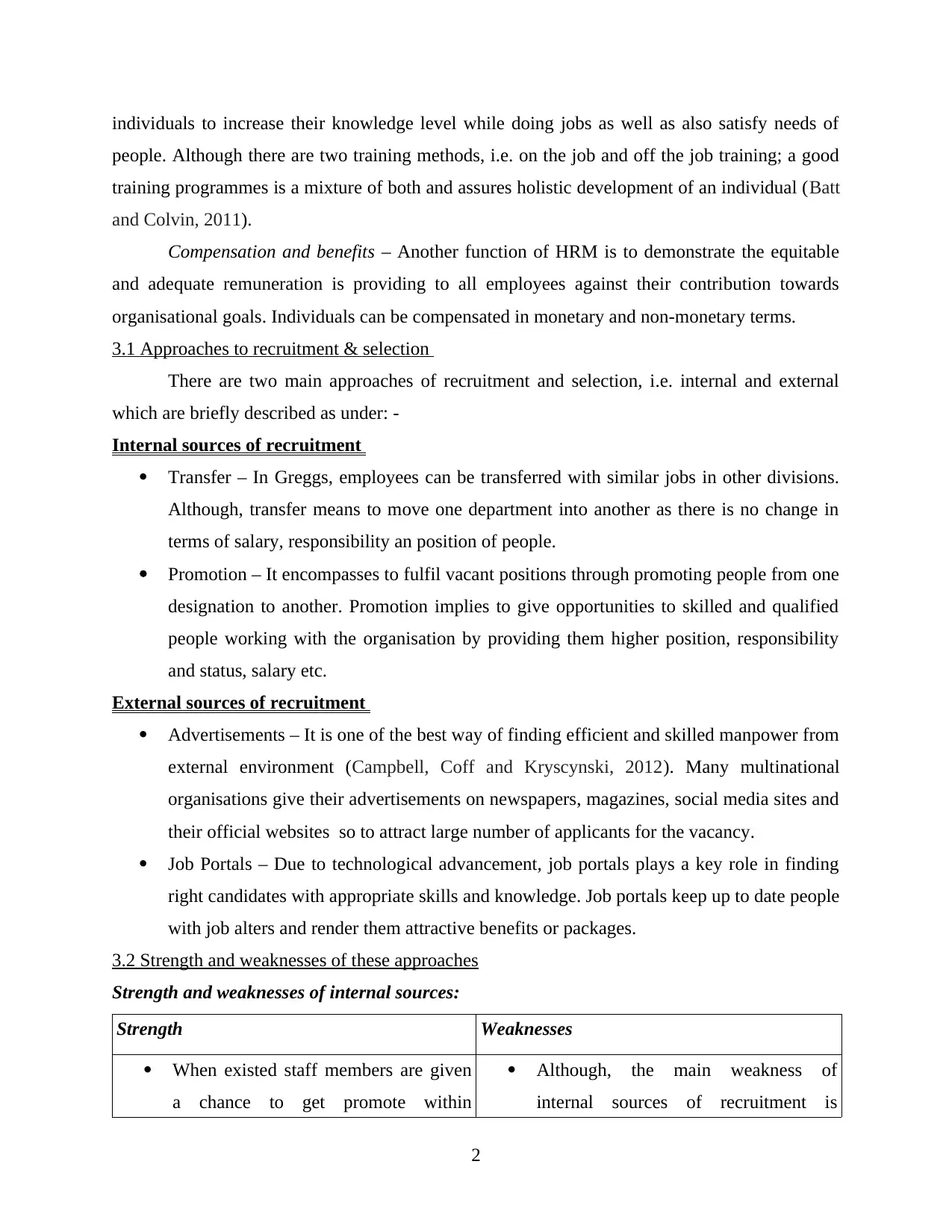
individuals to increase their knowledge level while doing jobs as well as also satisfy needs of
people. Although there are two training methods, i.e. on the job and off the job training; a good
training programmes is a mixture of both and assures holistic development of an individual (Batt
and Colvin, 2011).
Compensation and benefits – Another function of HRM is to demonstrate the equitable
and adequate remuneration is providing to all employees against their contribution towards
organisational goals. Individuals can be compensated in monetary and non-monetary terms.
3.1 Approaches to recruitment & selection
There are two main approaches of recruitment and selection, i.e. internal and external
which are briefly described as under: -
Internal sources of recruitment
Transfer – In Greggs, employees can be transferred with similar jobs in other divisions.
Although, transfer means to move one department into another as there is no change in
terms of salary, responsibility an position of people.
Promotion – It encompasses to fulfil vacant positions through promoting people from one
designation to another. Promotion implies to give opportunities to skilled and qualified
people working with the organisation by providing them higher position, responsibility
and status, salary etc.
External sources of recruitment
Advertisements – It is one of the best way of finding efficient and skilled manpower from
external environment (Campbell, Coff and Kryscynski, 2012). Many multinational
organisations give their advertisements on newspapers, magazines, social media sites and
their official websites so to attract large number of applicants for the vacancy.
Job Portals – Due to technological advancement, job portals plays a key role in finding
right candidates with appropriate skills and knowledge. Job portals keep up to date people
with job alters and render them attractive benefits or packages.
3.2 Strength and weaknesses of these approaches
Strength and weaknesses of internal sources:
Strength Weaknesses
When existed staff members are given
a chance to get promote within
Although, the main weakness of
internal sources of recruitment is
2
people. Although there are two training methods, i.e. on the job and off the job training; a good
training programmes is a mixture of both and assures holistic development of an individual (Batt
and Colvin, 2011).
Compensation and benefits – Another function of HRM is to demonstrate the equitable
and adequate remuneration is providing to all employees against their contribution towards
organisational goals. Individuals can be compensated in monetary and non-monetary terms.
3.1 Approaches to recruitment & selection
There are two main approaches of recruitment and selection, i.e. internal and external
which are briefly described as under: -
Internal sources of recruitment
Transfer – In Greggs, employees can be transferred with similar jobs in other divisions.
Although, transfer means to move one department into another as there is no change in
terms of salary, responsibility an position of people.
Promotion – It encompasses to fulfil vacant positions through promoting people from one
designation to another. Promotion implies to give opportunities to skilled and qualified
people working with the organisation by providing them higher position, responsibility
and status, salary etc.
External sources of recruitment
Advertisements – It is one of the best way of finding efficient and skilled manpower from
external environment (Campbell, Coff and Kryscynski, 2012). Many multinational
organisations give their advertisements on newspapers, magazines, social media sites and
their official websites so to attract large number of applicants for the vacancy.
Job Portals – Due to technological advancement, job portals plays a key role in finding
right candidates with appropriate skills and knowledge. Job portals keep up to date people
with job alters and render them attractive benefits or packages.
3.2 Strength and weaknesses of these approaches
Strength and weaknesses of internal sources:
Strength Weaknesses
When existed staff members are given
a chance to get promote within
Although, the main weakness of
internal sources of recruitment is
2
Paraphrase This Document
Need a fresh take? Get an instant paraphrase of this document with our AI Paraphraser
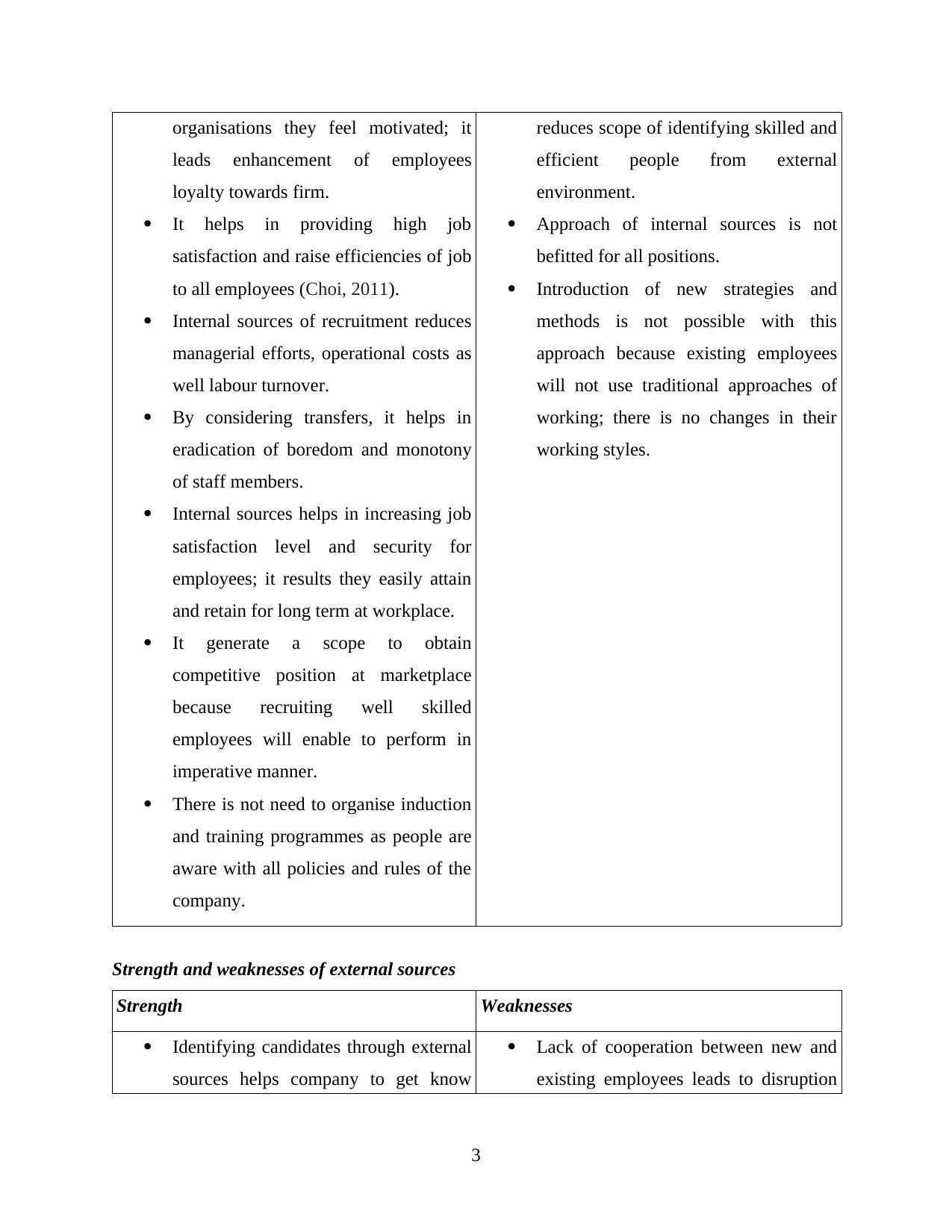
organisations they feel motivated; it
leads enhancement of employees
loyalty towards firm.
It helps in providing high job
satisfaction and raise efficiencies of job
to all employees (Choi, 2011).
Internal sources of recruitment reduces
managerial efforts, operational costs as
well labour turnover.
By considering transfers, it helps in
eradication of boredom and monotony
of staff members.
Internal sources helps in increasing job
satisfaction level and security for
employees; it results they easily attain
and retain for long term at workplace.
It generate a scope to obtain
competitive position at marketplace
because recruiting well skilled
employees will enable to perform in
imperative manner.
There is not need to organise induction
and training programmes as people are
aware with all policies and rules of the
company.
reduces scope of identifying skilled and
efficient people from external
environment.
Approach of internal sources is not
befitted for all positions.
Introduction of new strategies and
methods is not possible with this
approach because existing employees
will not use traditional approaches of
working; there is no changes in their
working styles.
Strength and weaknesses of external sources
Strength Weaknesses
Identifying candidates through external
sources helps company to get know
Lack of cooperation between new and
existing employees leads to disruption
3
leads enhancement of employees
loyalty towards firm.
It helps in providing high job
satisfaction and raise efficiencies of job
to all employees (Choi, 2011).
Internal sources of recruitment reduces
managerial efforts, operational costs as
well labour turnover.
By considering transfers, it helps in
eradication of boredom and monotony
of staff members.
Internal sources helps in increasing job
satisfaction level and security for
employees; it results they easily attain
and retain for long term at workplace.
It generate a scope to obtain
competitive position at marketplace
because recruiting well skilled
employees will enable to perform in
imperative manner.
There is not need to organise induction
and training programmes as people are
aware with all policies and rules of the
company.
reduces scope of identifying skilled and
efficient people from external
environment.
Approach of internal sources is not
befitted for all positions.
Introduction of new strategies and
methods is not possible with this
approach because existing employees
will not use traditional approaches of
working; there is no changes in their
working styles.
Strength and weaknesses of external sources
Strength Weaknesses
Identifying candidates through external
sources helps company to get know
Lack of cooperation between new and
existing employees leads to disruption
3
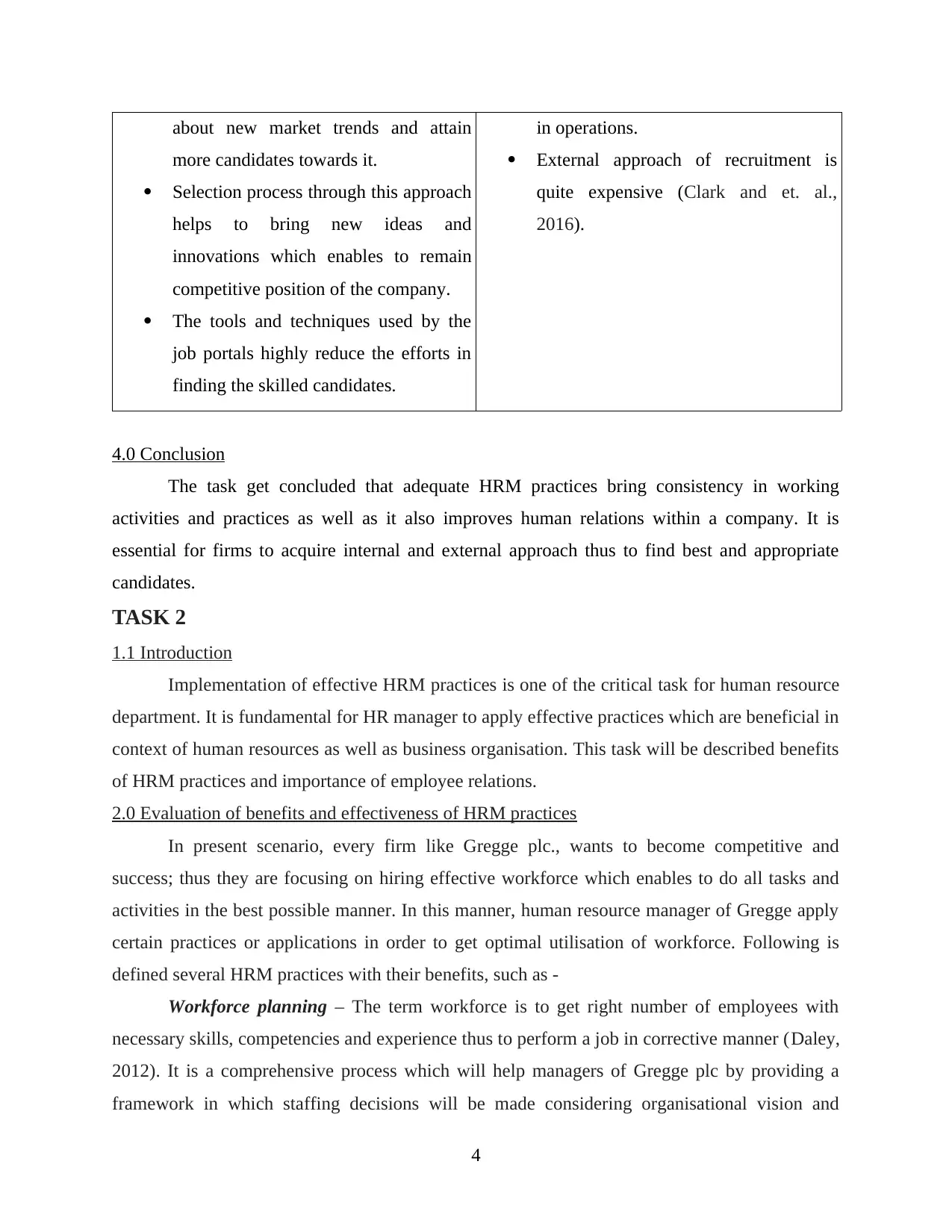
about new market trends and attain
more candidates towards it.
Selection process through this approach
helps to bring new ideas and
innovations which enables to remain
competitive position of the company.
The tools and techniques used by the
job portals highly reduce the efforts in
finding the skilled candidates.
in operations.
External approach of recruitment is
quite expensive (Clark and et. al.,
2016).
4.0 Conclusion
The task get concluded that adequate HRM practices bring consistency in working
activities and practices as well as it also improves human relations within a company. It is
essential for firms to acquire internal and external approach thus to find best and appropriate
candidates.
TASK 2
1.1 Introduction
Implementation of effective HRM practices is one of the critical task for human resource
department. It is fundamental for HR manager to apply effective practices which are beneficial in
context of human resources as well as business organisation. This task will be described benefits
of HRM practices and importance of employee relations.
2.0 Evaluation of benefits and effectiveness of HRM practices
In present scenario, every firm like Gregge plc., wants to become competitive and
success; thus they are focusing on hiring effective workforce which enables to do all tasks and
activities in the best possible manner. In this manner, human resource manager of Gregge apply
certain practices or applications in order to get optimal utilisation of workforce. Following is
defined several HRM practices with their benefits, such as -
Workforce planning – The term workforce is to get right number of employees with
necessary skills, competencies and experience thus to perform a job in corrective manner (Daley,
2012). It is a comprehensive process which will help managers of Gregge plc by providing a
framework in which staffing decisions will be made considering organisational vision and
4
more candidates towards it.
Selection process through this approach
helps to bring new ideas and
innovations which enables to remain
competitive position of the company.
The tools and techniques used by the
job portals highly reduce the efforts in
finding the skilled candidates.
in operations.
External approach of recruitment is
quite expensive (Clark and et. al.,
2016).
4.0 Conclusion
The task get concluded that adequate HRM practices bring consistency in working
activities and practices as well as it also improves human relations within a company. It is
essential for firms to acquire internal and external approach thus to find best and appropriate
candidates.
TASK 2
1.1 Introduction
Implementation of effective HRM practices is one of the critical task for human resource
department. It is fundamental for HR manager to apply effective practices which are beneficial in
context of human resources as well as business organisation. This task will be described benefits
of HRM practices and importance of employee relations.
2.0 Evaluation of benefits and effectiveness of HRM practices
In present scenario, every firm like Gregge plc., wants to become competitive and
success; thus they are focusing on hiring effective workforce which enables to do all tasks and
activities in the best possible manner. In this manner, human resource manager of Gregge apply
certain practices or applications in order to get optimal utilisation of workforce. Following is
defined several HRM practices with their benefits, such as -
Workforce planning – The term workforce is to get right number of employees with
necessary skills, competencies and experience thus to perform a job in corrective manner (Daley,
2012). It is a comprehensive process which will help managers of Gregge plc by providing a
framework in which staffing decisions will be made considering organisational vision and
4
⊘ This is a preview!⊘
Do you want full access?
Subscribe today to unlock all pages.

Trusted by 1+ million students worldwide
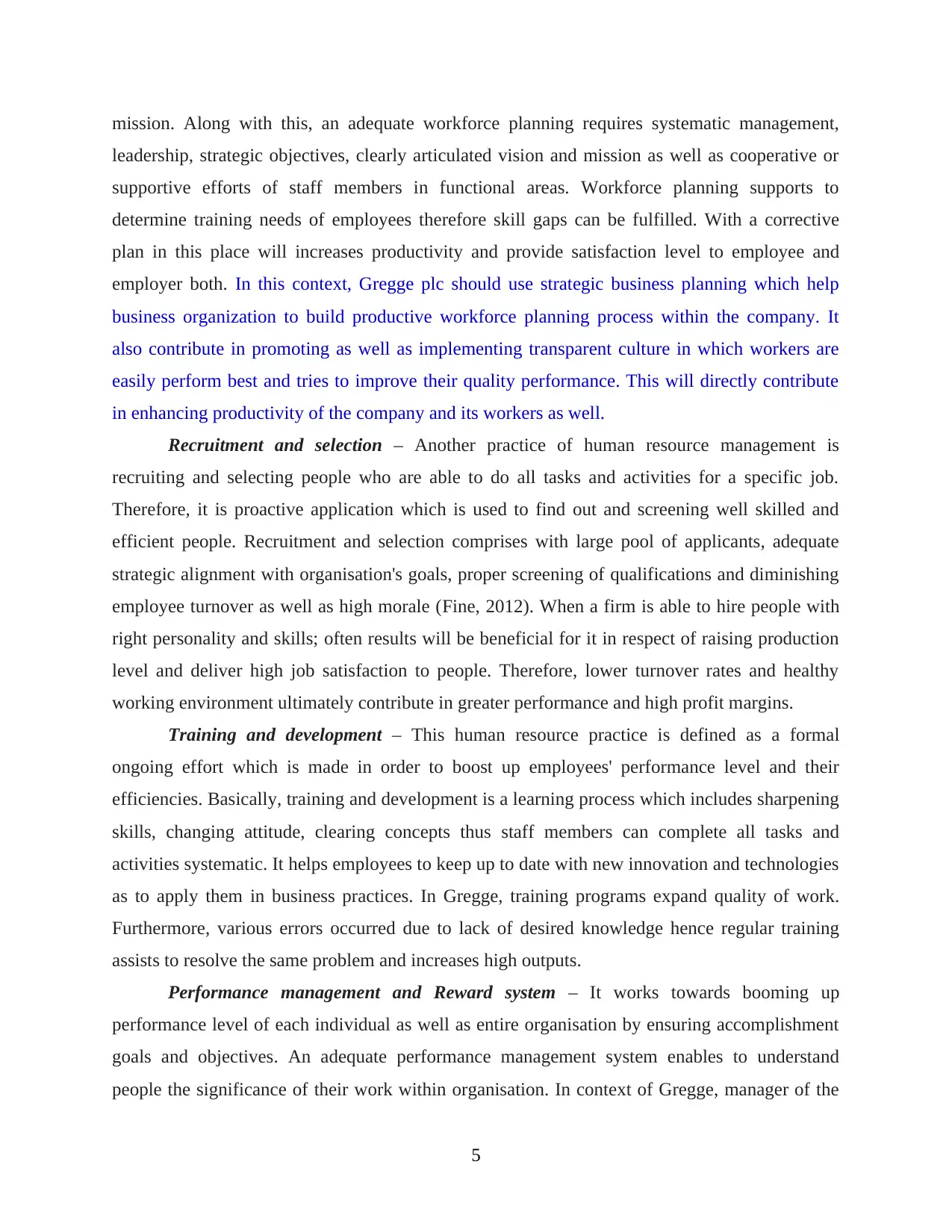
mission. Along with this, an adequate workforce planning requires systematic management,
leadership, strategic objectives, clearly articulated vision and mission as well as cooperative or
supportive efforts of staff members in functional areas. Workforce planning supports to
determine training needs of employees therefore skill gaps can be fulfilled. With a corrective
plan in this place will increases productivity and provide satisfaction level to employee and
employer both. In this context, Gregge plc should use strategic business planning which help
business organization to build productive workforce planning process within the company. It
also contribute in promoting as well as implementing transparent culture in which workers are
easily perform best and tries to improve their quality performance. This will directly contribute
in enhancing productivity of the company and its workers as well.
Recruitment and selection – Another practice of human resource management is
recruiting and selecting people who are able to do all tasks and activities for a specific job.
Therefore, it is proactive application which is used to find out and screening well skilled and
efficient people. Recruitment and selection comprises with large pool of applicants, adequate
strategic alignment with organisation's goals, proper screening of qualifications and diminishing
employee turnover as well as high morale (Fine, 2012). When a firm is able to hire people with
right personality and skills; often results will be beneficial for it in respect of raising production
level and deliver high job satisfaction to people. Therefore, lower turnover rates and healthy
working environment ultimately contribute in greater performance and high profit margins.
Training and development – This human resource practice is defined as a formal
ongoing effort which is made in order to boost up employees' performance level and their
efficiencies. Basically, training and development is a learning process which includes sharpening
skills, changing attitude, clearing concepts thus staff members can complete all tasks and
activities systematic. It helps employees to keep up to date with new innovation and technologies
as to apply them in business practices. In Gregge, training programs expand quality of work.
Furthermore, various errors occurred due to lack of desired knowledge hence regular training
assists to resolve the same problem and increases high outputs.
Performance management and Reward system – It works towards booming up
performance level of each individual as well as entire organisation by ensuring accomplishment
goals and objectives. An adequate performance management system enables to understand
people the significance of their work within organisation. In context of Gregge, manager of the
5
leadership, strategic objectives, clearly articulated vision and mission as well as cooperative or
supportive efforts of staff members in functional areas. Workforce planning supports to
determine training needs of employees therefore skill gaps can be fulfilled. With a corrective
plan in this place will increases productivity and provide satisfaction level to employee and
employer both. In this context, Gregge plc should use strategic business planning which help
business organization to build productive workforce planning process within the company. It
also contribute in promoting as well as implementing transparent culture in which workers are
easily perform best and tries to improve their quality performance. This will directly contribute
in enhancing productivity of the company and its workers as well.
Recruitment and selection – Another practice of human resource management is
recruiting and selecting people who are able to do all tasks and activities for a specific job.
Therefore, it is proactive application which is used to find out and screening well skilled and
efficient people. Recruitment and selection comprises with large pool of applicants, adequate
strategic alignment with organisation's goals, proper screening of qualifications and diminishing
employee turnover as well as high morale (Fine, 2012). When a firm is able to hire people with
right personality and skills; often results will be beneficial for it in respect of raising production
level and deliver high job satisfaction to people. Therefore, lower turnover rates and healthy
working environment ultimately contribute in greater performance and high profit margins.
Training and development – This human resource practice is defined as a formal
ongoing effort which is made in order to boost up employees' performance level and their
efficiencies. Basically, training and development is a learning process which includes sharpening
skills, changing attitude, clearing concepts thus staff members can complete all tasks and
activities systematic. It helps employees to keep up to date with new innovation and technologies
as to apply them in business practices. In Gregge, training programs expand quality of work.
Furthermore, various errors occurred due to lack of desired knowledge hence regular training
assists to resolve the same problem and increases high outputs.
Performance management and Reward system – It works towards booming up
performance level of each individual as well as entire organisation by ensuring accomplishment
goals and objectives. An adequate performance management system enables to understand
people the significance of their work within organisation. In context of Gregge, manager of the
5
Paraphrase This Document
Need a fresh take? Get an instant paraphrase of this document with our AI Paraphraser
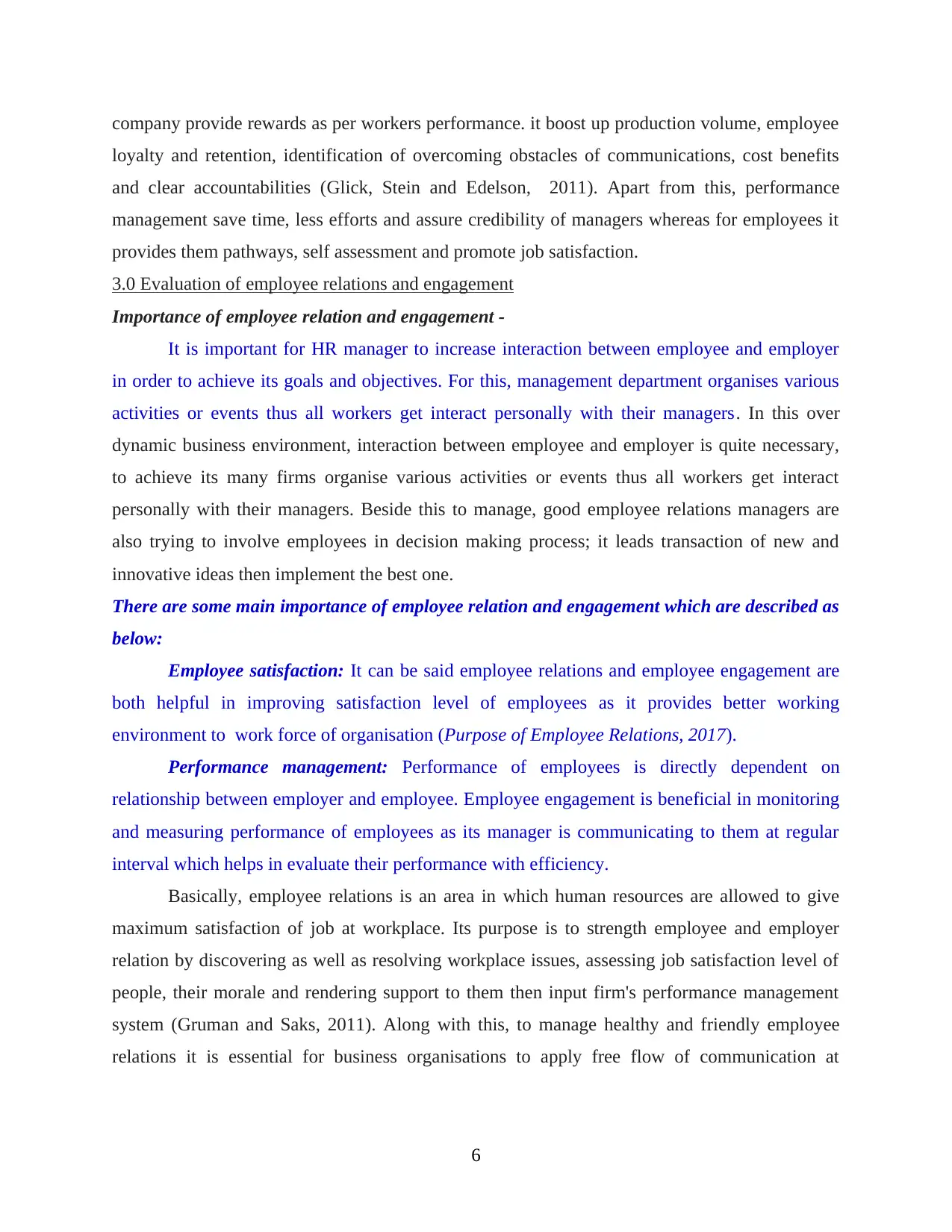
company provide rewards as per workers performance. it boost up production volume, employee
loyalty and retention, identification of overcoming obstacles of communications, cost benefits
and clear accountabilities (Glick, Stein and Edelson, 2011). Apart from this, performance
management save time, less efforts and assure credibility of managers whereas for employees it
provides them pathways, self assessment and promote job satisfaction.
3.0 Evaluation of employee relations and engagement
Importance of employee relation and engagement -
It is important for HR manager to increase interaction between employee and employer
in order to achieve its goals and objectives. For this, management department organises various
activities or events thus all workers get interact personally with their managers. In this over
dynamic business environment, interaction between employee and employer is quite necessary,
to achieve its many firms organise various activities or events thus all workers get interact
personally with their managers. Beside this to manage, good employee relations managers are
also trying to involve employees in decision making process; it leads transaction of new and
innovative ideas then implement the best one.
There are some main importance of employee relation and engagement which are described as
below:
Employee satisfaction: It can be said employee relations and employee engagement are
both helpful in improving satisfaction level of employees as it provides better working
environment to work force of organisation (Purpose of Employee Relations, 2017).
Performance management: Performance of employees is directly dependent on
relationship between employer and employee. Employee engagement is beneficial in monitoring
and measuring performance of employees as its manager is communicating to them at regular
interval which helps in evaluate their performance with efficiency.
Basically, employee relations is an area in which human resources are allowed to give
maximum satisfaction of job at workplace. Its purpose is to strength employee and employer
relation by discovering as well as resolving workplace issues, assessing job satisfaction level of
people, their morale and rendering support to them then input firm's performance management
system (Gruman and Saks, 2011). Along with this, to manage healthy and friendly employee
relations it is essential for business organisations to apply free flow of communication at
6
loyalty and retention, identification of overcoming obstacles of communications, cost benefits
and clear accountabilities (Glick, Stein and Edelson, 2011). Apart from this, performance
management save time, less efforts and assure credibility of managers whereas for employees it
provides them pathways, self assessment and promote job satisfaction.
3.0 Evaluation of employee relations and engagement
Importance of employee relation and engagement -
It is important for HR manager to increase interaction between employee and employer
in order to achieve its goals and objectives. For this, management department organises various
activities or events thus all workers get interact personally with their managers. In this over
dynamic business environment, interaction between employee and employer is quite necessary,
to achieve its many firms organise various activities or events thus all workers get interact
personally with their managers. Beside this to manage, good employee relations managers are
also trying to involve employees in decision making process; it leads transaction of new and
innovative ideas then implement the best one.
There are some main importance of employee relation and engagement which are described as
below:
Employee satisfaction: It can be said employee relations and employee engagement are
both helpful in improving satisfaction level of employees as it provides better working
environment to work force of organisation (Purpose of Employee Relations, 2017).
Performance management: Performance of employees is directly dependent on
relationship between employer and employee. Employee engagement is beneficial in monitoring
and measuring performance of employees as its manager is communicating to them at regular
interval which helps in evaluate their performance with efficiency.
Basically, employee relations is an area in which human resources are allowed to give
maximum satisfaction of job at workplace. Its purpose is to strength employee and employer
relation by discovering as well as resolving workplace issues, assessing job satisfaction level of
people, their morale and rendering support to them then input firm's performance management
system (Gruman and Saks, 2011). Along with this, to manage healthy and friendly employee
relations it is essential for business organisations to apply free flow of communication at
6
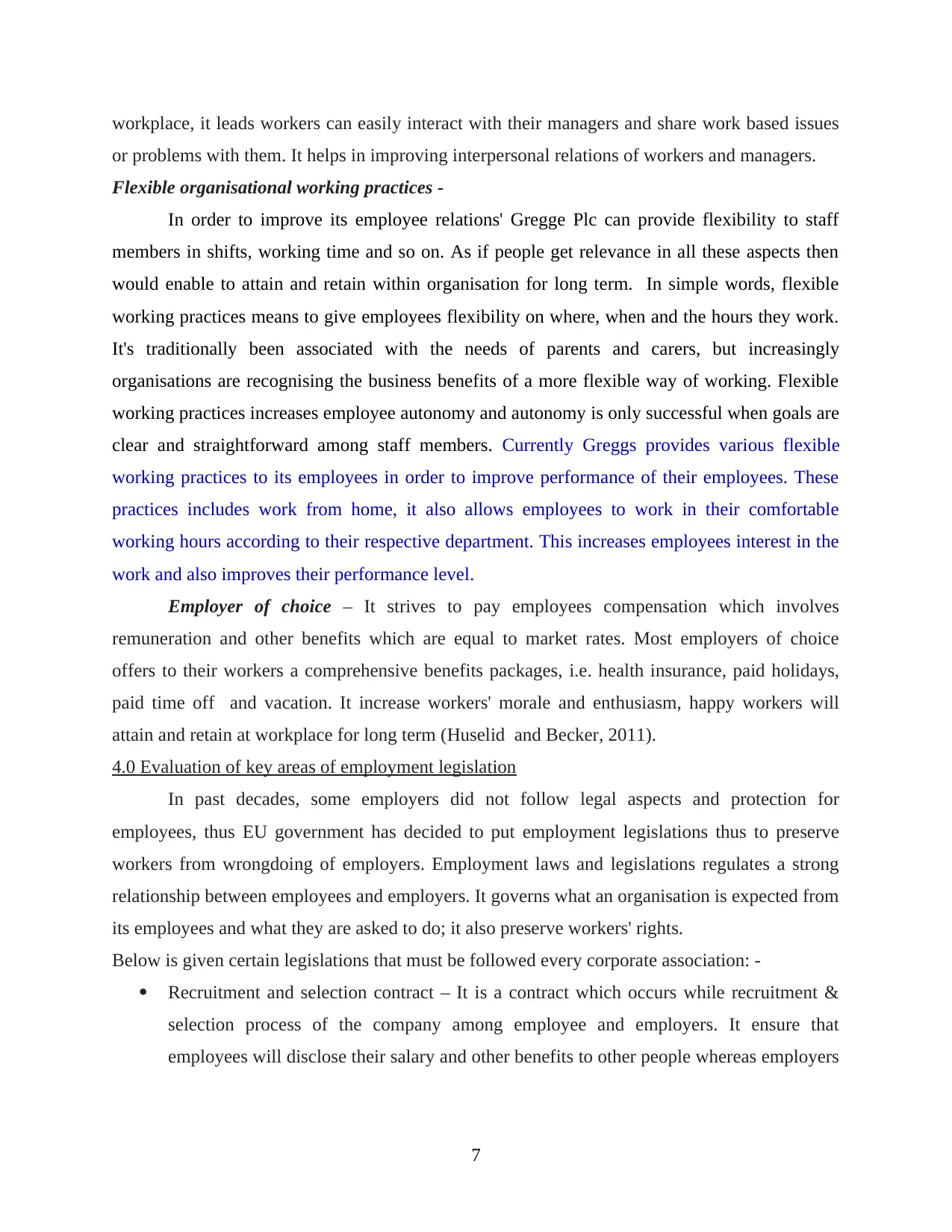
workplace, it leads workers can easily interact with their managers and share work based issues
or problems with them. It helps in improving interpersonal relations of workers and managers.
Flexible organisational working practices -
In order to improve its employee relations' Gregge Plc can provide flexibility to staff
members in shifts, working time and so on. As if people get relevance in all these aspects then
would enable to attain and retain within organisation for long term. In simple words, flexible
working practices means to give employees flexibility on where, when and the hours they work.
It's traditionally been associated with the needs of parents and carers, but increasingly
organisations are recognising the business benefits of a more flexible way of working. Flexible
working practices increases employee autonomy and autonomy is only successful when goals are
clear and straightforward among staff members. Currently Greggs provides various flexible
working practices to its employees in order to improve performance of their employees. These
practices includes work from home, it also allows employees to work in their comfortable
working hours according to their respective department. This increases employees interest in the
work and also improves their performance level.
Employer of choice – It strives to pay employees compensation which involves
remuneration and other benefits which are equal to market rates. Most employers of choice
offers to their workers a comprehensive benefits packages, i.e. health insurance, paid holidays,
paid time off and vacation. It increase workers' morale and enthusiasm, happy workers will
attain and retain at workplace for long term (Huselid and Becker, 2011).
4.0 Evaluation of key areas of employment legislation
In past decades, some employers did not follow legal aspects and protection for
employees, thus EU government has decided to put employment legislations thus to preserve
workers from wrongdoing of employers. Employment laws and legislations regulates a strong
relationship between employees and employers. It governs what an organisation is expected from
its employees and what they are asked to do; it also preserve workers' rights.
Below is given certain legislations that must be followed every corporate association: -
Recruitment and selection contract – It is a contract which occurs while recruitment &
selection process of the company among employee and employers. It ensure that
employees will disclose their salary and other benefits to other people whereas employers
7
or problems with them. It helps in improving interpersonal relations of workers and managers.
Flexible organisational working practices -
In order to improve its employee relations' Gregge Plc can provide flexibility to staff
members in shifts, working time and so on. As if people get relevance in all these aspects then
would enable to attain and retain within organisation for long term. In simple words, flexible
working practices means to give employees flexibility on where, when and the hours they work.
It's traditionally been associated with the needs of parents and carers, but increasingly
organisations are recognising the business benefits of a more flexible way of working. Flexible
working practices increases employee autonomy and autonomy is only successful when goals are
clear and straightforward among staff members. Currently Greggs provides various flexible
working practices to its employees in order to improve performance of their employees. These
practices includes work from home, it also allows employees to work in their comfortable
working hours according to their respective department. This increases employees interest in the
work and also improves their performance level.
Employer of choice – It strives to pay employees compensation which involves
remuneration and other benefits which are equal to market rates. Most employers of choice
offers to their workers a comprehensive benefits packages, i.e. health insurance, paid holidays,
paid time off and vacation. It increase workers' morale and enthusiasm, happy workers will
attain and retain at workplace for long term (Huselid and Becker, 2011).
4.0 Evaluation of key areas of employment legislation
In past decades, some employers did not follow legal aspects and protection for
employees, thus EU government has decided to put employment legislations thus to preserve
workers from wrongdoing of employers. Employment laws and legislations regulates a strong
relationship between employees and employers. It governs what an organisation is expected from
its employees and what they are asked to do; it also preserve workers' rights.
Below is given certain legislations that must be followed every corporate association: -
Recruitment and selection contract – It is a contract which occurs while recruitment &
selection process of the company among employee and employers. It ensure that
employees will disclose their salary and other benefits to other people whereas employers
7
⊘ This is a preview!⊘
Do you want full access?
Subscribe today to unlock all pages.

Trusted by 1+ million students worldwide
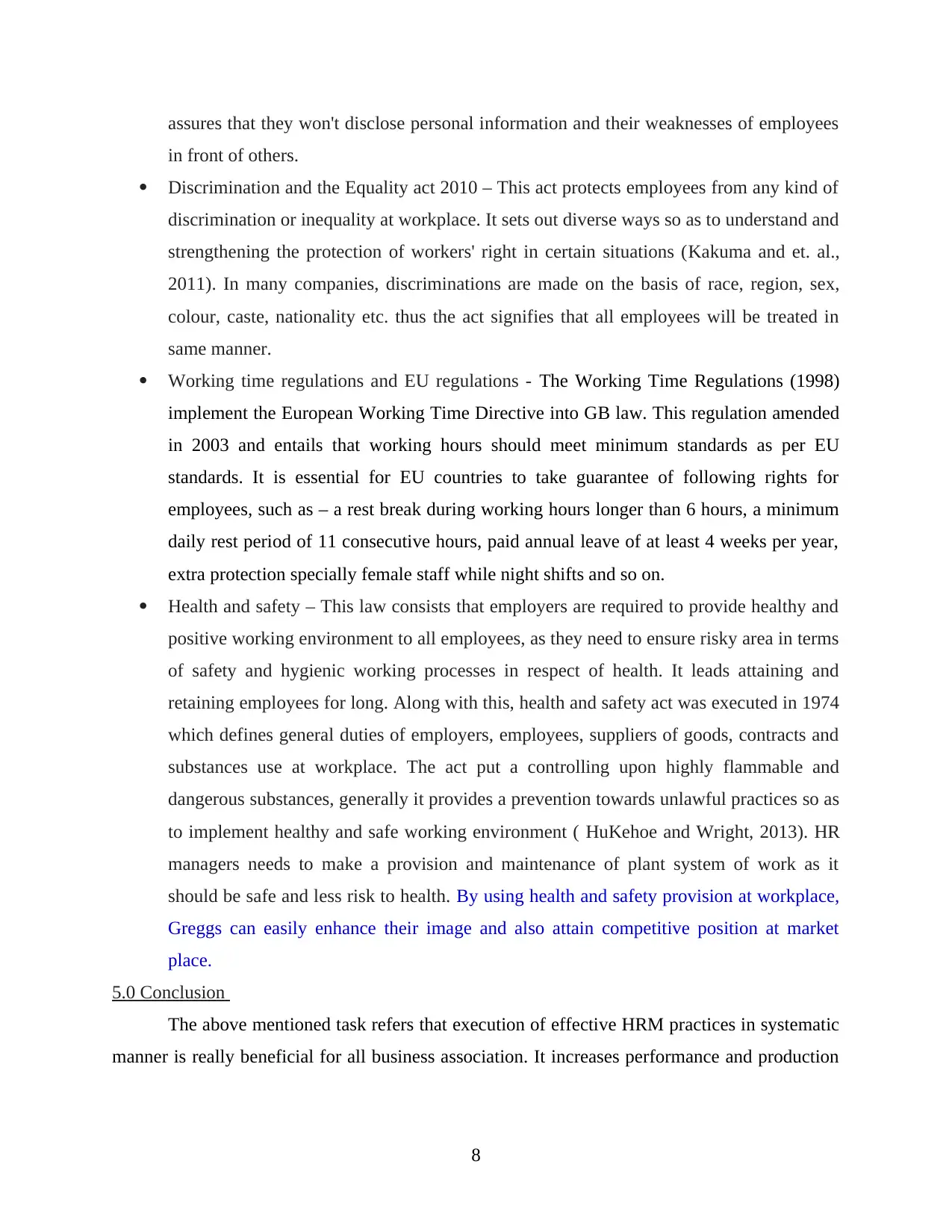
assures that they won't disclose personal information and their weaknesses of employees
in front of others.
Discrimination and the Equality act 2010 – This act protects employees from any kind of
discrimination or inequality at workplace. It sets out diverse ways so as to understand and
strengthening the protection of workers' right in certain situations (Kakuma and et. al.,
2011). In many companies, discriminations are made on the basis of race, region, sex,
colour, caste, nationality etc. thus the act signifies that all employees will be treated in
same manner.
Working time regulations and EU regulations - The Working Time Regulations (1998)
implement the European Working Time Directive into GB law. This regulation amended
in 2003 and entails that working hours should meet minimum standards as per EU
standards. It is essential for EU countries to take guarantee of following rights for
employees, such as – a rest break during working hours longer than 6 hours, a minimum
daily rest period of 11 consecutive hours, paid annual leave of at least 4 weeks per year,
extra protection specially female staff while night shifts and so on.
Health and safety – This law consists that employers are required to provide healthy and
positive working environment to all employees, as they need to ensure risky area in terms
of safety and hygienic working processes in respect of health. It leads attaining and
retaining employees for long. Along with this, health and safety act was executed in 1974
which defines general duties of employers, employees, suppliers of goods, contracts and
substances use at workplace. The act put a controlling upon highly flammable and
dangerous substances, generally it provides a prevention towards unlawful practices so as
to implement healthy and safe working environment ( HuKehoe and Wright, 2013). HR
managers needs to make a provision and maintenance of plant system of work as it
should be safe and less risk to health. By using health and safety provision at workplace,
Greggs can easily enhance their image and also attain competitive position at market
place.
5.0 Conclusion
The above mentioned task refers that execution of effective HRM practices in systematic
manner is really beneficial for all business association. It increases performance and production
8
in front of others.
Discrimination and the Equality act 2010 – This act protects employees from any kind of
discrimination or inequality at workplace. It sets out diverse ways so as to understand and
strengthening the protection of workers' right in certain situations (Kakuma and et. al.,
2011). In many companies, discriminations are made on the basis of race, region, sex,
colour, caste, nationality etc. thus the act signifies that all employees will be treated in
same manner.
Working time regulations and EU regulations - The Working Time Regulations (1998)
implement the European Working Time Directive into GB law. This regulation amended
in 2003 and entails that working hours should meet minimum standards as per EU
standards. It is essential for EU countries to take guarantee of following rights for
employees, such as – a rest break during working hours longer than 6 hours, a minimum
daily rest period of 11 consecutive hours, paid annual leave of at least 4 weeks per year,
extra protection specially female staff while night shifts and so on.
Health and safety – This law consists that employers are required to provide healthy and
positive working environment to all employees, as they need to ensure risky area in terms
of safety and hygienic working processes in respect of health. It leads attaining and
retaining employees for long. Along with this, health and safety act was executed in 1974
which defines general duties of employers, employees, suppliers of goods, contracts and
substances use at workplace. The act put a controlling upon highly flammable and
dangerous substances, generally it provides a prevention towards unlawful practices so as
to implement healthy and safe working environment ( HuKehoe and Wright, 2013). HR
managers needs to make a provision and maintenance of plant system of work as it
should be safe and less risk to health. By using health and safety provision at workplace,
Greggs can easily enhance their image and also attain competitive position at market
place.
5.0 Conclusion
The above mentioned task refers that execution of effective HRM practices in systematic
manner is really beneficial for all business association. It increases performance and production
8
Paraphrase This Document
Need a fresh take? Get an instant paraphrase of this document with our AI Paraphraser
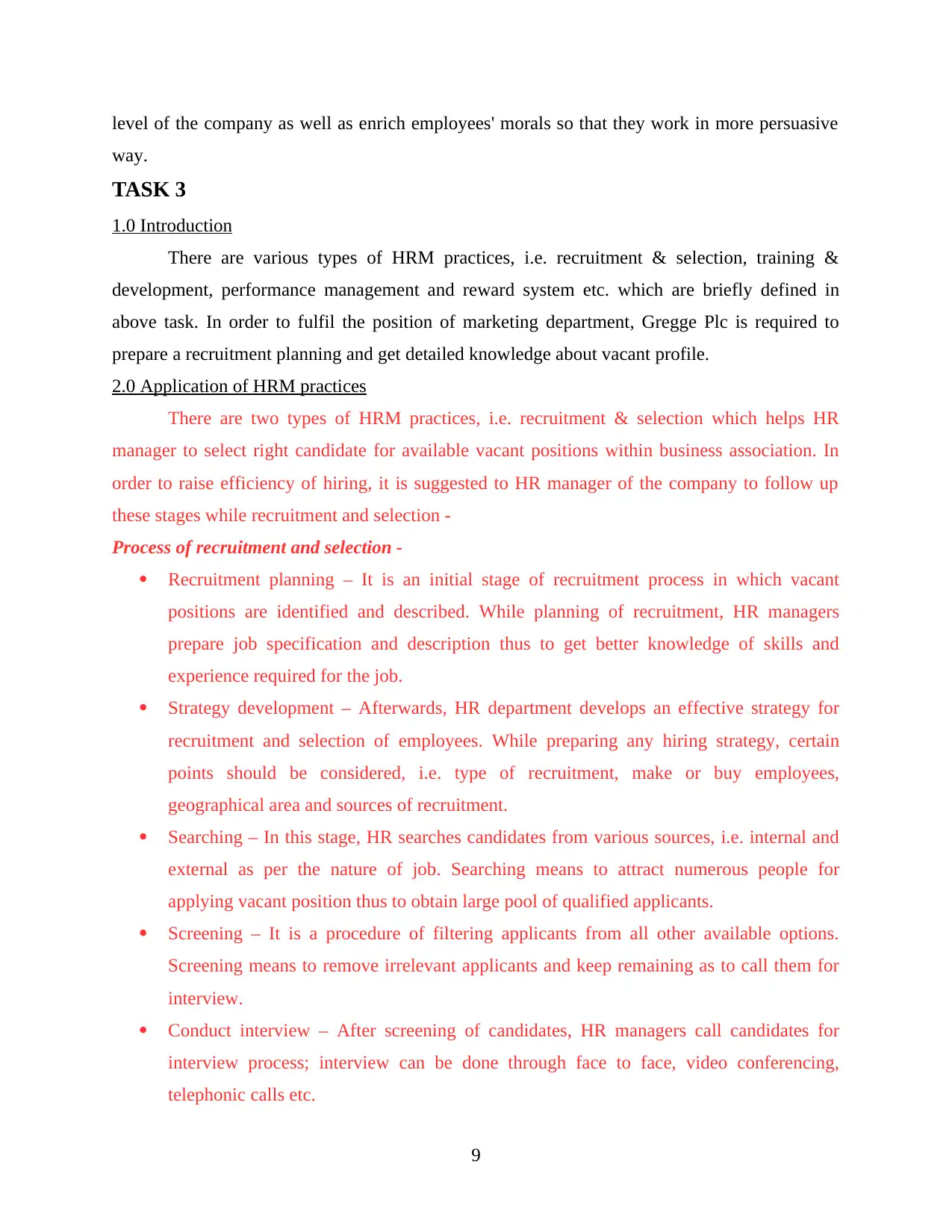
level of the company as well as enrich employees' morals so that they work in more persuasive
way.
TASK 3
1.0 Introduction
There are various types of HRM practices, i.e. recruitment & selection, training &
development, performance management and reward system etc. which are briefly defined in
above task. In order to fulfil the position of marketing department, Gregge Plc is required to
prepare a recruitment planning and get detailed knowledge about vacant profile.
2.0 Application of HRM practices
There are two types of HRM practices, i.e. recruitment & selection which helps HR
manager to select right candidate for available vacant positions within business association. In
order to raise efficiency of hiring, it is suggested to HR manager of the company to follow up
these stages while recruitment and selection -
Process of recruitment and selection -
Recruitment planning – It is an initial stage of recruitment process in which vacant
positions are identified and described. While planning of recruitment, HR managers
prepare job specification and description thus to get better knowledge of skills and
experience required for the job.
Strategy development – Afterwards, HR department develops an effective strategy for
recruitment and selection of employees. While preparing any hiring strategy, certain
points should be considered, i.e. type of recruitment, make or buy employees,
geographical area and sources of recruitment.
Searching – In this stage, HR searches candidates from various sources, i.e. internal and
external as per the nature of job. Searching means to attract numerous people for
applying vacant position thus to obtain large pool of qualified applicants.
Screening – It is a procedure of filtering applicants from all other available options.
Screening means to remove irrelevant applicants and keep remaining as to call them for
interview.
Conduct interview – After screening of candidates, HR managers call candidates for
interview process; interview can be done through face to face, video conferencing,
telephonic calls etc.
9
way.
TASK 3
1.0 Introduction
There are various types of HRM practices, i.e. recruitment & selection, training &
development, performance management and reward system etc. which are briefly defined in
above task. In order to fulfil the position of marketing department, Gregge Plc is required to
prepare a recruitment planning and get detailed knowledge about vacant profile.
2.0 Application of HRM practices
There are two types of HRM practices, i.e. recruitment & selection which helps HR
manager to select right candidate for available vacant positions within business association. In
order to raise efficiency of hiring, it is suggested to HR manager of the company to follow up
these stages while recruitment and selection -
Process of recruitment and selection -
Recruitment planning – It is an initial stage of recruitment process in which vacant
positions are identified and described. While planning of recruitment, HR managers
prepare job specification and description thus to get better knowledge of skills and
experience required for the job.
Strategy development – Afterwards, HR department develops an effective strategy for
recruitment and selection of employees. While preparing any hiring strategy, certain
points should be considered, i.e. type of recruitment, make or buy employees,
geographical area and sources of recruitment.
Searching – In this stage, HR searches candidates from various sources, i.e. internal and
external as per the nature of job. Searching means to attract numerous people for
applying vacant position thus to obtain large pool of qualified applicants.
Screening – It is a procedure of filtering applicants from all other available options.
Screening means to remove irrelevant applicants and keep remaining as to call them for
interview.
Conduct interview – After screening of candidates, HR managers call candidates for
interview process; interview can be done through face to face, video conferencing,
telephonic calls etc.
9
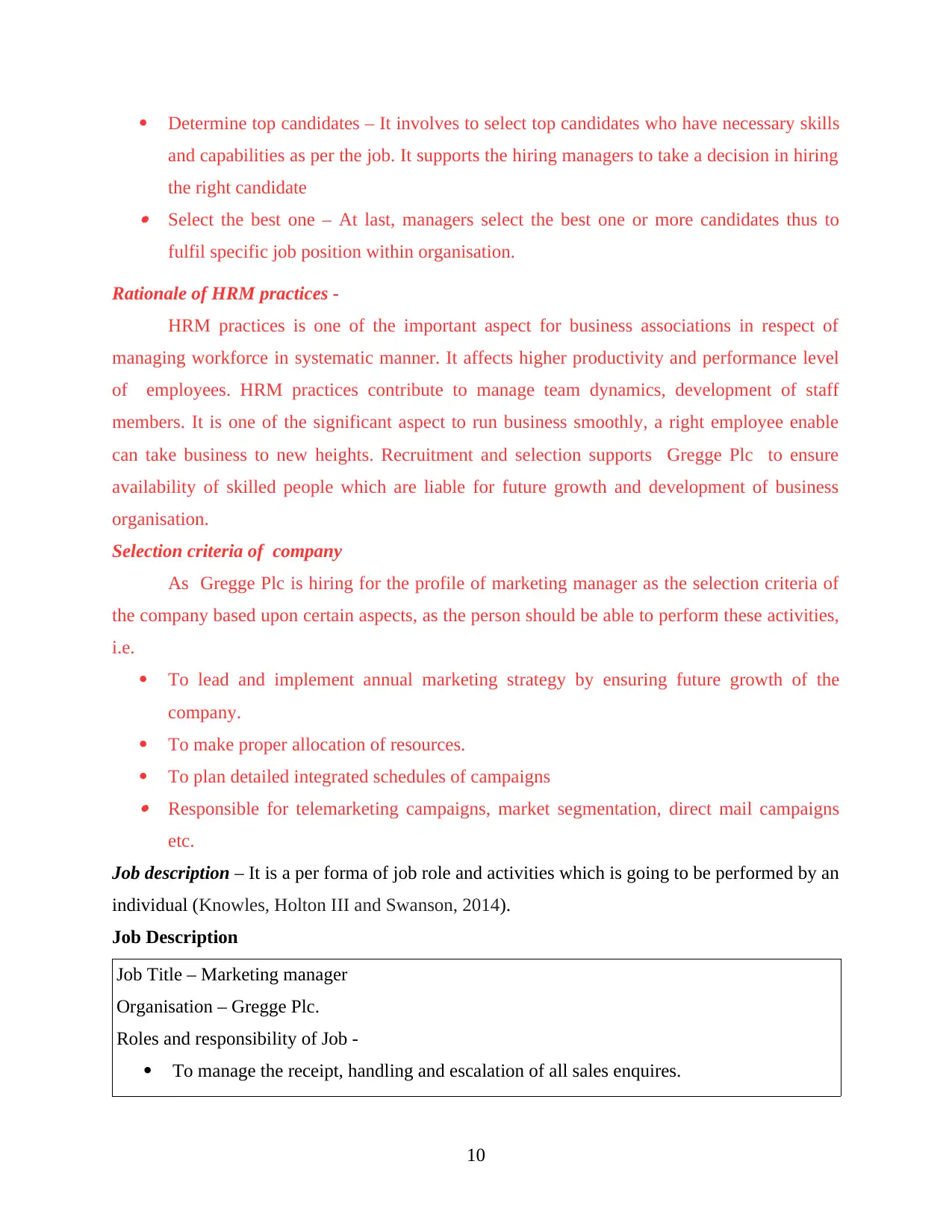
Determine top candidates – It involves to select top candidates who have necessary skills
and capabilities as per the job. It supports the hiring managers to take a decision in hiring
the right candidate Select the best one – At last, managers select the best one or more candidates thus to
fulfil specific job position within organisation.
Rationale of HRM practices -
HRM practices is one of the important aspect for business associations in respect of
managing workforce in systematic manner. It affects higher productivity and performance level
of employees. HRM practices contribute to manage team dynamics, development of staff
members. It is one of the significant aspect to run business smoothly, a right employee enable
can take business to new heights. Recruitment and selection supports Gregge Plc to ensure
availability of skilled people which are liable for future growth and development of business
organisation.
Selection criteria of company
As Gregge Plc is hiring for the profile of marketing manager as the selection criteria of
the company based upon certain aspects, as the person should be able to perform these activities,
i.e.
To lead and implement annual marketing strategy by ensuring future growth of the
company.
To make proper allocation of resources.
To plan detailed integrated schedules of campaigns Responsible for telemarketing campaigns, market segmentation, direct mail campaigns
etc.
Job description – It is a per forma of job role and activities which is going to be performed by an
individual (Knowles, Holton III and Swanson, 2014).
Job Description
Job Title – Marketing manager
Organisation – Gregge Plc.
Roles and responsibility of Job -
To manage the receipt, handling and escalation of all sales enquires.
10
and capabilities as per the job. It supports the hiring managers to take a decision in hiring
the right candidate Select the best one – At last, managers select the best one or more candidates thus to
fulfil specific job position within organisation.
Rationale of HRM practices -
HRM practices is one of the important aspect for business associations in respect of
managing workforce in systematic manner. It affects higher productivity and performance level
of employees. HRM practices contribute to manage team dynamics, development of staff
members. It is one of the significant aspect to run business smoothly, a right employee enable
can take business to new heights. Recruitment and selection supports Gregge Plc to ensure
availability of skilled people which are liable for future growth and development of business
organisation.
Selection criteria of company
As Gregge Plc is hiring for the profile of marketing manager as the selection criteria of
the company based upon certain aspects, as the person should be able to perform these activities,
i.e.
To lead and implement annual marketing strategy by ensuring future growth of the
company.
To make proper allocation of resources.
To plan detailed integrated schedules of campaigns Responsible for telemarketing campaigns, market segmentation, direct mail campaigns
etc.
Job description – It is a per forma of job role and activities which is going to be performed by an
individual (Knowles, Holton III and Swanson, 2014).
Job Description
Job Title – Marketing manager
Organisation – Gregge Plc.
Roles and responsibility of Job -
To manage the receipt, handling and escalation of all sales enquires.
10
⊘ This is a preview!⊘
Do you want full access?
Subscribe today to unlock all pages.

Trusted by 1+ million students worldwide
1 out of 16
Related Documents
Your All-in-One AI-Powered Toolkit for Academic Success.
+13062052269
info@desklib.com
Available 24*7 on WhatsApp / Email
![[object Object]](/_next/static/media/star-bottom.7253800d.svg)
Unlock your academic potential
Copyright © 2020–2025 A2Z Services. All Rights Reserved. Developed and managed by ZUCOL.




